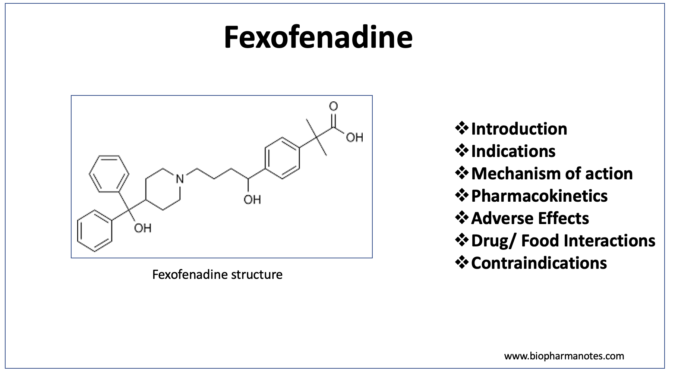
- Fexofenadine is second generation, selective, non-sedating histamine (H1) receptor antagonist. Chemically, it belongs to piperidine class. It is metabolite of terfenadine.
- It was approved for its medical use by FDA in 1996. Nowadays, it is also available as generic medicine. It was approved to be sold as OTC (over the counter) medicine on January 25. 2011.
- H1 receptor antihistaminic drugs are commonly used in treatment of allergic disorder, allergic conjunctivitis and in mastocytosis. First generation H1 receptor antagonist is non- specific and produce sedation in therapeutic doses. Second generation H1 receptor antagonist including cetirizine, fexofenadine is highly specific, non- sedating in therapeutic doses and doesn’t exert anti-muscarinic, anti-serotonergic and antibradykinin action.
Indications of fexofenadine
- Used in treating symptoms of seasonal allergic rhinitis including runny nose, sneezing, watery eyes and itching.
- Used in chronic idiopathic urticaria.
- It is used both in adults and children.
Mechanism of action of fexofenadine
- H1 histamine receptor play important role in mediation of allergic reaction and hypersensitivity. H1 receptors are mostly present in neuronal system, smooth muscles, immune cells, and endothelium. Activation of H1 receptors by histamine may cause itching, pain, hypotension, tachycardia, cough, bronchoconstriction, and increased permeability.
- Fexofenadine selectively antagonizes peripheral H1 receptors present in immune cells, endothelium and immune cells and reverses the effect of histamine resulting in decreased vascular permeability, inhibition of histamine induced bronchospasm and decrease in amount of fluid escape from tissue to capillaries.
- It doesn’t cross blood brain barrier in large extent unlike first generation antihistamines. Hence, it doesn’t have much effect on H1 receptors present in neurons and produces minimum sedation. It doesn’t have affinity for cholinergic and alpha- adrenergic receptors and hence doesn’t possess anticholinergic side effects.
Pharmacokinetics of fexofenadine
- It is administered via oral route and is available as tablet, oral suspension, or oral disintegrating tablets. Its absolute bioavailability is around 33%. Co-administration of fexofenadine with fruit juices including apple, grapefruit or orange juice may decrease its bioavailability by inhibiting P- glycoprotein transporter. Hence, it should not be administered with fruit juice, and it is recommended to be administered only with water.
- It is transported by p- glycoproteins and other transport proteins. Its action starts after around 2 hours of administration. It has long duration of action and is administered once per day. Its half-life is around 11-15 hours.
- Around 60-70% of fexofenadine binds to plasma proteins, mainly albumin and a-1 glycoprotein. Only 5% of administered drug undergoes hepatic metabolism. It is primarily excreted via feces in unchanged form.
Adverse effects
- Most common side effects are drowsiness, dry mouth, headache, GI symptoms including nausea, abdominal pain, and diarrhea.
- It can also cause cold, flu, menstrual problems, and fatigue.
Drug/Food Interactions
- Drugs like erythromycin, verapamil, itraconazole and ketoconazole which inhibits p-glycoprotein may increase plasma concentration of fexofenadine.
- It should not be administered with apple, orange or grapefruit juice as its absorption may be decreased.
Contraindications
- Contraindicated in patients with known hypersensitivity to fexofenadine or any components of the formulation.
- It is pregnancy category C drug and is used only when its benefits outweigh the risks.
References
- https://go.drugbank.com/drugs/DB00950
- https://www.ncbi.nlm.nih.gov/books/NBK556104/
- Axelrod D et al. Fexofenadine hydrochloride in the treatment of allergic disease: a review. J Asthma Allergy. 2008; 1: 19–29.
- Principles of Clinical Pharmacology (Third Edition). 2012. 239-257.
- Pharmacology and Pharmacotherapeutics. 24th edition.